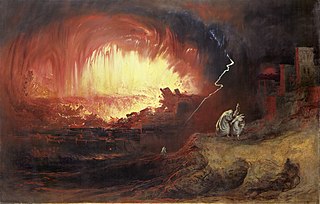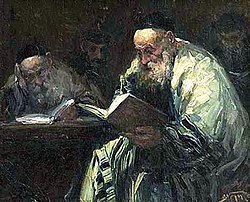Judah ha-Nasi or Judah I, known simply as Rebbi or Rabbi, was a second-century rabbi and chief redactor and editor of the Mishnah. He lived from approximately 135 to 217 CE. He was a key leader of the Jewish community in Roman-occupied Judea after the Bar Kokhba revolt.

Akiva ben Joseph, also known as Rabbi Akiva, was a leading Jewish scholar and sage, a tanna of the latter part of the first century and the beginning of the second century. Rabbi Akiva was a leading contributor to the Mishnah and to Midrash halakha. He is referred to in the Talmud as Rosh la-Hakhamim -"Chief of the Sages". He was executed by the Romans in the aftermath of the Bar Kokhba revolt.

Bereshit, Bereishit, Bereshis, Bereishis, or B'reshith is the first weekly Torah portion in the annual Jewish cycle of Torah reading. The parashah consists of Genesis 1:1–6:8.

Vayeira, Vayera, or Va-yera is the fourth weekly Torah portion in the annual Jewish cycle of Torah reading. It constitutes Genesis 18:1–22:24. The parashah tells the stories of Abraham's three visitors, Abraham's bargaining with God over Sodom and Gomorrah, Lot's two visitors, Lot's bargaining with the Sodomites, Lot's flight, the destruction of Sodom and Gomorrah, how Lot's daughters became pregnant by their father, how Abraham once again passed off his wife Sarah as his sister, the birth of Isaac, the expulsion of Hagar, disputes over wells, and the binding of Isaac.
Dosetai is a Hebraized form of the Greek given name Dositheus meaning "gift of God". It was extremely popular in late classical Judea and among Jewish communities in Egypt, and corresponds to the Hebrew "Mattaniah" or "Nethaneel," which seems to have been a favorite one both in Palestine and in Alexandria.

Noach, Noiach, Nauach, Nauah, or Noah is the second weekly Torah portion in the annual Jewish cycle of Torah reading. It constitutes Genesis 6:9–11:32. The parashah tells the stories of the Flood and Noah's Ark, of Noah's subsequent drunkenness and cursing of Canaan, and of the Tower of Babel.

Chayei Sarah, Chaye Sarah, Ḥayye Sarah, or Ḥayyei Sara, is the fifth weekly Torah portion in the annual Jewish cycle of Torah reading. It constitutes Genesis 23:1–25:18. The parashah tells the stories of Abraham's negotiations to purchase a burial place for his wife Sarah and his servant's mission to find a wife for Abraham's son Isaac.
Eliezer ben Jose was a Jewish rabbi who lived in Judea in the 2nd century CE. He was the son of Jose the Galilean, and is regarded as a tanna of the fourth generation. He was a pupil of Rabbi Akiva.
Joshua ben Hananiah, also known as Rabbi Yehoshua, was a leading tanna of the first half-century following the destruction of the Second Temple. He is the seventh-most-frequently mentioned sage in the Mishnah.
Samuel ben Nahman or Samuel [bar] Nahmani was a rabbi of the Talmud, known as an amora, who lived in the Land of Israel from the beginning of the 3rd century until the beginning of the 4th century.

Pirkei de-Rabbi Eliezer is an aggadic-midrashic work on the Torah containing exegesis and retellings of biblical stories.
Tanhuma bar Abba was a Jewish amora of the 5th generation, one of the foremost aggadists of his time.
Levi II, or Rabbi Levi was a Jewish scholar of the 3rd century. In a few cases he is quoted as Levi bar Laḥma (Hama). In later midrashim the title "Berabbi" is sometimes added to his name.

Allusions in rabbinic literature to the Biblical character Noah, who saved his family and representatives of all the animals from a great flood by constructing an ark, contain various expansions, elaborations and inferences beyond what is presented in the text of the Bible itself.

Allusions in rabbinic literature to the Biblical story of Daniel contain various expansions, elaborations and inferences beyond the text presented in the Book of Daniel. These stories are describing Jewish success in the Diaspora, where it was important to emphasize Jewish wisdom and statecraft during periods of foreign domination in order to strengthen the sense of worth and ethnic pride of the Jewish people.

Allusions in rabbinic literature to the Biblical character Job, the object of sufferings and tribulations in the Book of Job, contain various expansions, elaborations and inferences beyond what is presented in the text of the Bible itself.
Rabbi Aha was a rabbi of the Land of Israel, of the fourth century.
Rabbi Isaac Nappaha, or Isaac the smith, was a rabbi of the 3rd-4th centuries who lived in the Galilee.
Rabbi Alexandri is the name of one or more amoraim.
Rabbi Aibu was a rabbi of the Land of Israel, who lived in the 4th century.






